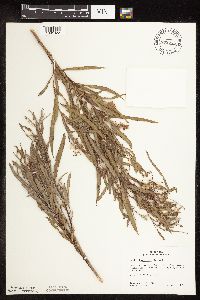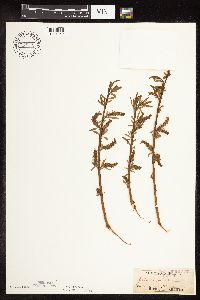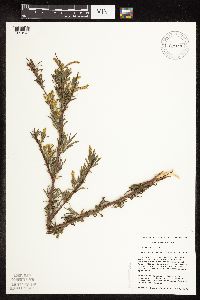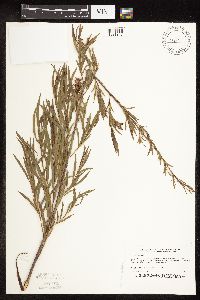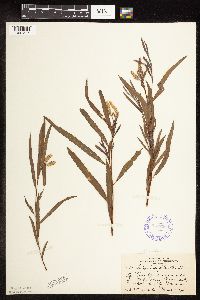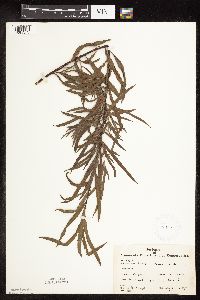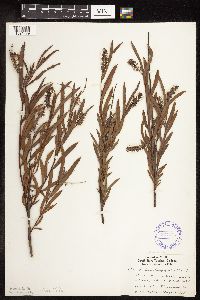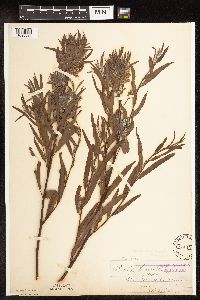Salix interior
|
|
|
|
Family: Salicaceae
Sandbar Willow
[Salix exigua f. wheeleri (Rowlee) C. F. Reed, moreSalix interior f. wheeleri (Rowlee) Rouleau, Salix rubra Richardson] |
Shrubs or trees, 4-9 m. Stems: branches gray-brown to red-brown, glabrous or villous; branchlets yellow brown to red-brown, densely tomentose or villous to glabrescent. Leaves: stipules absent or rudimentary on early ones, rudimentary or foliaceous on late ones; petiole 1-5(-9) mm, glabrous or sparsely villous adaxially; largest medial blade linear to lorate, 60-160 × 4-11 mm, (6.5-)11-19(-31) times as long as wide, base cuneate, margins flat, remotely spinulose-serrulate (teeth 2-5 per cm), apex acute or subacuminate, abaxial surface thinly glaucous, densely villous or long-silky to glabrescent, adaxial slightly glossy, pilose or densely villous to glabrescent; proximal blade margins entire; juvenile blade reddish or yellowish green, moderately densely to sparsely long-silky abaxially. Catkins (flowering throughout season); staminate 20-61 × 4-10 mm, flowering branchlet 3-20 mm; pistillate loosely flowered, slender or stout, 20-67 × 5-9 mm, flowering branchlet 3-19 mm; floral bract (sometimes greenish), 1.5-3.5 mm, apex acute, acuminate, or rounded, entire, erose, or toothed, abaxially hairy either proximally or distally, hairs wavy. Staminate flowers: abaxial nectary 0.5-1.1 mm, adaxial nectary ovate, narrowly oblong, or flask-shaped, 0.6-1.4 mm, nectaries distinct; filaments hairy; anthers 0.4-0.9 mm. Pistillate flowers: adaxial nectary narrowly oblong, 0.4-1.1 mm, shorter to longer than stipe; stipe 0.4-0.8 mm; ovary obclavate to pyriform, glabrous, glabrescent, or long-silky, beak abruptly tapering to styles; ovules 16-36 per ovary; styles 0-0.2 mm; stigmas flat, abaxially non-papillate with pointed tip, or broadly cylindrical, 0.3-0.7 mm. Capsules (4-)5-8(-10) mm. 2n = 38. Flowering early Apr-early Jul. Sandy to silty flood plains, margins of lakes, ponds, and prairie sloughs, dry prairie sand hills, marshes, disturbed areas; 10-1800 m; Alta., B.C., Man., N.B., N.W.T., Ont., Que., Sask., Yukon; Alaska, Ark., Colo., Conn., Del., D.C., Ill., Ind., Iowa, Kans., Ky., La., Maine, Md., Mich., Minn., Miss., Mo., Mont., Nebr., N.J., N.Y., N.Dak., Ohio, Okla., Pa., S.Dak., Tenn., Tex., Va., W.Va., Wis., Wyo.; Mexico (Tamaulipas, Veracruz). Sometimes Salix interior is treated as a subspecies of S. exigua (R. D. Dorn 1998). Salix exigua and S. interior hybridize and apparently intergrade in the western Great Plains; because the area of overlap is relatively small and distinctiveness of the two taxa is not compromised by hybridization and introgression, it is best to treat them as separate species. Leaves on sylleptic shoots are usually very densely silky. Salix interior sometimes has shoots that arise from buds on either side of the normal axillary bud. They do not seem to be directly related to the stipules because they are enclosed by the petiole. Catkins with both staminate and pistillate flowers are rare in S. interior, but a Quebec specimen had some catkins predominantly pistillate and others staminate; most were a mixture. The flowers were not teratological, but a mature capsule contained aborted ovules. Hybrids: Salix interior forms natural hybrids with S. exigua var. exigua. Controlled pollinations using S. interior (as S. exigua) from southern Ontario (A. Mosseler 1990) successfully produced F1 hybrids with S. bebbiana, S. discolor, S. eriocephala, and S. petiolaris. Seed production was usually relatively low, except in crosses with S. discolor. In general, F1 viability was relatively low in crosses with these members of subg. Vetrix. No seeds were produced in crosses with members of subgenera Protitea or Salix. Morphology of the hybrids usually was intermediate between the two parents, but when S. petiolaris was used as the maternal parent, the F1s more closely resembled that species. J. Salick and E. Pfeffer (1999) extended these findings to show that, although crosses between S. interior (as S. exigua) and S. eriocephala are partially sterile, their clonal growth parameters (sprouting, shoot length, and biomass production) are strong and thus permit these partially sterile hybrids to exist as successful individuals and perhaps to '... make a contribution to interspecific gene flow over time.' Of particular taxonomic interest is that, in this cross, the staminate parent has a significant influence on leaf shape, whereas in the cross S. eriocephala × S. petiolaris it is the pistillate parent that is significant for leaf shape. Relatively few hybrids resembling those produ Small tree 5 - 7.5 m tall, trunk diameter less than 30 cm Leaves: alternate, nearly stalkless, green, 5 - 15 cm long, 3 mm - 1.25 cm wide (many times longer than wide), narrowly lance-shaped with a tapering base and pointed tip, widely gland-toothed, and sometimes softly hairy beneath. Flowers: either male or female, borne on separate trees (dioecious) in cylindrical catkins. The catkin is slightly hairy and grows on a short, leafy stalk. Female catkin greenish with pale yellow scales, 4 - 8 cm long. Ovary hairy. Male catkin 2 - 4 cm long. Stamens two, with yellow anthers. Fruit: a capsule, in elongated clusters, stalked, light brown, 7 - 9 mm long, flask-shaped, and slightly hairy. Seeds have long, white, silky hairs attached. Bark: thin and smooth on young trees, becoming gray, furrowed, and broken into rough scales. Twigs: slender and grayish green. Leaf scars U-shaped with three bundle scars each. Buds: pale brown, to 4 mm long, and cylindrical. Form: irregular. Similar species: In the Chicago Region, Salix interior differs from all other willows by having narrowly lance-shaped leaves with widely spaced, glandular teeth. Flowering: late April to late July, with the leaves Habitat and ecology: By far the most common willow of the Chicago Region. Found in low ground, where it forms huge vegetative colonies. Also grows on the sandy beaches of Lake Michigan, along streams and pond borders, and in other moist areas. Occurence in the Chicago region: native Notes: Salix interior should not be planted in the vicinity of smaller shrubs, due to its vigorous suckering habit. Native Americans made baskets from the twigs and bark. The wood is used for fuel. Etymology: Salix is the Latin word for willow. Interior means inner. Author: The Morton Arboretum From Flora of Indiana (1940) by Charles C. Deam Found throughout the state along streams, especially on gravelly bars, about lakes, and along ditches. It usually forms dense colonies and often covers large areas. The form [var. wheeleri, characerized by more oblong leaves that are often greater than 1 cm wide,] is common along the Ohio River where it is associated with the species [Salix interior] but may easily be distinguished at a long distance by its bluish green color. …… Indiana Coefficient of Conservatism: C = 1 Wetland Indicator Status: FACW |
|
|
|




















































